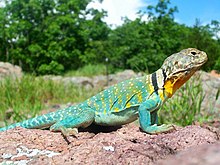Common collared lizard
| Eastern collared lizard Crotaphytus collaris |
|
|---|---|
 |
|
| A common collared lizard in Taum Sauk Mountain State Park, Missouri | |
| Scientific classification | |
| Kingdom: | Animalia |
| Phylum: | Chordata |
| Subphylum: | Vertebrata |
| Class: | Reptilia |
| Order: | Squamata |
| Suborder: | Iguania |
| Family: | Crotaphytidae |
| Genus: | Crotaphytus |
| Species: | C. collaris |
| Binomial name | |
|
Crotaphytus collaris (Say, 1823) |
|
| Synonyms | |
|
|
The eastern collared lizard (Crotaphytus collaris), also called common collared lizard,Oklahoma collared lizard or collared lizard, is a North American lizard that can reach 8–14 inches (20–36 cm) in length (including the tail), with a large head and powerful jaws. They are well known for the ability to run on their hind legs, looking like small versions of the popular images of theropod dinosaurs. Chiefly found in dry, open regions of Mexico and the south-central United States including Missouri, Texas, Arizona, and Kansas, the full extent of its habitat in the United States ranges from the Ozark Mountains to southern California. The collared lizard is the state reptile of Oklahoma, where it is known as the mountain boomer.
The name "collared lizard" comes from the lizard's distinct coloration, which includes bands of black around the neck and shoulders that look like a collar. It is a member of the collared lizard family.
The origin of the name "mountain boomer" is not clear, but it may be traceable to settlers traveling west during the Gold Rush. One theory is that settlers mistook the sound of wind in canyons for the call of an animal in an area where the collared lizard was abundant. In reality, collared lizards are silent.
Like many other lizards, including the frilled lizard and basilisk, collared lizards can run on their hind legs, and are relatively fast sprinters. Record speeds have been around 16 miles per hour (26 km/h), much slower than the world record for lizards (21.5 mph or 34.6 km/h) attained by the larger-bodied Costa Rican spiny-tailed iguana, Ctenosaura similis.
...
Wikipedia
